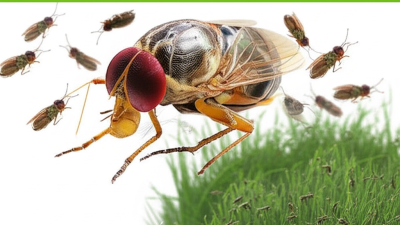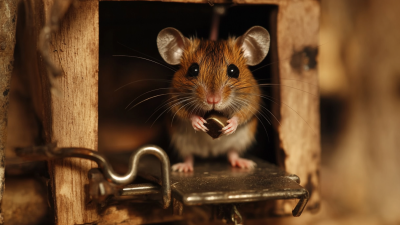
 Bird & Pigeon Pest Control
Bird & Pigeon Pest Control  Mice & Rat Pest Control
Mice & Rat Pest Control  Mole & Vole & Gopher Pest Control
Mole & Vole & Gopher Pest Control  Fly Insect Pest Control
Fly Insect Pest Control  Wasp & Bee Pest Control
Wasp & Bee Pest Control  Moth Pest Control
Moth Pest Control  Mosquito Pest Control
Mosquito Pest Control  Cockroach Pest Control
Cockroach Pest Control  Wildlife Pest Control
Wildlife Pest Control  Snake Pest Control
Snake Pest Control  Bed Bug & Flea Pest Control
Bed Bug & Flea Pest Control  Snail & Slug Pest Control
Snail & Slug Pest Control  Ant & Termites Pest Control
Ant & Termites Pest Control  Spider Pest Control
Spider Pest Control  Other Insect Pest Control
Other Insect Pest Control  Garden Products
Garden Products  Blog
Blog Fruit flies can be more than just a minor annoyance; they can seriously disrupt a peaceful home environment. Their rapid reproduction and attraction to overripe fruits and fermented substances make them a persistent pest in many households. Understanding how to effectively utilize a Fruit Fly Trap is essential for anyone looking to reclaim their living space from these small yet troublesome insects. In this article, we will delve into the most successful strategies and innovative designs for Fruit Fly Traps, offering practical solutions that are both easy to implement and environmentally friendly. By unlocking the secrets behind these traps, readers will learn how to create an effective barrier against fruit flies, ensuring a pest-free home and a more enjoyable living experience. Join us as we explore the best methods and tips to keep these unwanted guests at bay.

 Understanding the lifecycle of fruit flies is essential for deploying effective traps and eliminating these pests from your home. Fruit flies typically begin their life as eggs laid on fermenting fruits and vegetables. Within a day, the larvae emerge and begin to feed on the decaying organic matter, leading to rapid population growth. This short lifecycle—spanning just about a week from egg to adult—means that a small infestation can quickly become overwhelming if not addressed promptly.
Understanding the lifecycle of fruit flies is essential for deploying effective traps and eliminating these pests from your home. Fruit flies typically begin their life as eggs laid on fermenting fruits and vegetables. Within a day, the larvae emerge and begin to feed on the decaying organic matter, leading to rapid population growth. This short lifecycle—spanning just about a week from egg to adult—means that a small infestation can quickly become overwhelming if not addressed promptly.
To combat fruit flies effectively, it is crucial to target all stages of their lifecycle. Traps that attract and capture adult flies can significantly reduce the breeding population. Homemade traps, such as those using vinegar or wine, can lure adult flies, while maintaining cleanliness and eliminating food sources will help prevent eggs from being laid. Understanding when and where fruit flies reproduce can enhance the effectiveness of traps, ensuring your efforts lead to a pest-free environment.
By applying this knowledge, homeowners can create a comprehensive strategy to manage and control fruit fly populations efficiently.
Fruit flies can be a persistent nuisance, especially in late summer and autumn when they tend to multiply rapidly. Fortunately, there are several effective DIY solutions to help keep your home pest-free. One of the most popular methods involves using apple cider vinegar. This natural trap is not only affordable but extremely effective at catching these small flies. Simply fill a bowl with apple cider vinegar, cover it with plastic wrap, and poke small holes in the top. The enticing scent will draw the flies in, while the plastic wrap prevents their escape.
Another effective trap can be made with a mix of dish soap and vinegar. Combine a few drops of dish soap with vinegar in a bowl. The soap breaks the surface tension of the vinegar, causing the flies to sink instead of floating. This simple yet ingenious method yields quick results.
Tips to enhance your fruit fly traps include: placing traps near fruit bowls and garbage cans, regularly cleaning up spills and crumbs, and ensuring ripe fruit is stored in the refrigerator. By implementing these traps and tips, you can enjoy a pest-free home effortlessly.
| Trap Type | Materials Needed | Setup Instructions | Effectiveness (1-10) | Estimated Cost ($) |
|---|---|---|---|---|
| Fruit Vinegar Trap | Apple cider vinegar, bowl, plastic wrap | Pour vinegar into the bowl, cover with plastic wrap, poke holes. | 8 | 2 |
| Wine Bottle Trap | Empty wine bottle, fruit scraps | Place fruit scraps in bottle; flies will enter and can't escape. | 7 | 0 |
| Paper Cone Trap | Paper, tape, vinegar or juice | Roll paper into a cone, place in jar with vinegar/juice. | 9 | 1 |
| Milk and Sugar Trap | Milk, sugar, jar | Mix milk and sugar in jar; fly attraction leads to drowning. | 6 | 0.5 |
| Soap and Water Trap | Water, dish soap, bowl | Add soap to water in bowl; flies drown upon landing. | 8 | 1 |
Choosing the right bait is essential for attracting fruit flies effectively. Many people underestimate the benefit of using simple, household items as bait. Overripe fruits, apple cider vinegar, and even a mixture of sugar and water can serve as excellent attractants. The key is to make your trap appealing enough for fruit flies to enter while ensuring it remains easy to clean and maintain.
Tips: When preparing your bait, consider adding a drop of dish soap to the liquid bait; this breaks the surface tension, preventing flies from escaping once they land. Additionally, placing the trap in areas where fruit flies are frequently spotted — like kitchens or near garbage — increases your chances of capturing them.
There has been a surge of interest in using effective fruit fly traps, especially with the warmer weather bringing these pests out in droves. Users have reported significant success with affordable traps that can capture over a hundred flies at once. Investing in these efficient traps not only fosters a pest-free environment but also offers a cost-effective solution for long-term pest management. Keeping your home tidy and minimizing exposed food waste can further enhance your efforts in fruit fly control.
Setting effective fruit fly traps can significantly reduce the annoyance of pests in your home, but common mistakes can hinder their success. One prevalent mistake is the use of improper bait. While ripe fruits may seem like a good option, fruit flies are often attracted to fermented substances. Using vinegar or a mix of sugar and water can be far more effective. Additionally, it’s crucial to position the traps correctly. Placing them too far from the fruit fly source means that fewer flies will be captured. Instead, the traps should be strategically located in areas where fruit flies are most active.

Another common error is neglecting to regularly change the bait and clean the traps. Over time, the effectiveness of the bait diminishes, and flies may lose interest. Replace the bait every few days and clean the traps to ensure they remain functional. Furthermore, ensuring that there are no lingering sources of fruit fly attraction, such as old fruit or leftovers, is essential. Attending to these details will significantly improve your success in trapping these pests and maintaining a pest-free environment in your home.
After successfully catching fruit flies with effective DIY traps, it's essential to maintain a pest-free home to prevent future infestations. One of the simplest yet most potent techniques involves keeping your kitchen clean and free of breeding grounds. Regularly wash your fruits with vinegar upon bringing them home, as this not only cleans them but also removes any potential eggs or larvae that may be present. Additionally, make it a habit to wipe down surfaces and dispose of overripe fruits promptly to discourage these pests from nesting in your home.
Another effective preventive measure is to use natural deterrents like apple cider vinegar traps. By placing these traps around your kitchen, you can catch any stray fruit flies that might still linger. To further enhance your defenses, consider incorporating other solutions such as gnat traps made from common household items. By employing these strategies consistently, you can ensure your home remains a fruit fly-free zone while creating a healthier environment for everyone.
This chart illustrates the effectiveness of various homemade and commercial fruit fly traps based on the number of fruit flies they caught. The data indicates that commercial traps tend to catch the most flies, followed by vinegar and wine traps, while beer traps are the least effective.







